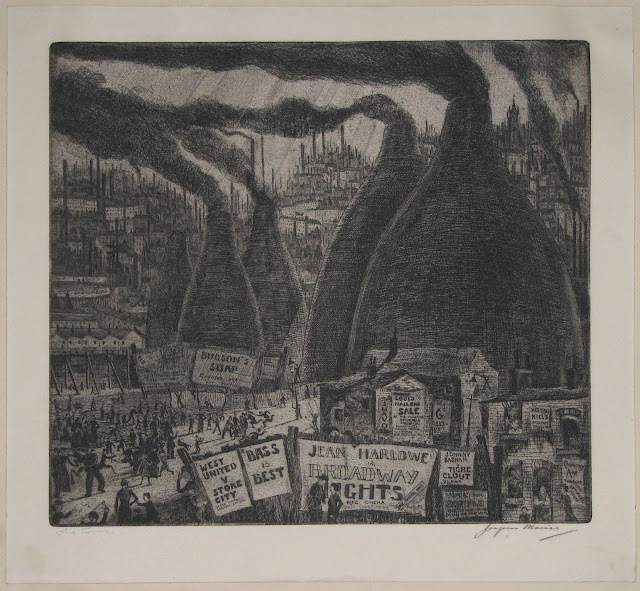Antique prints: Environmentally Friendly Decor
Five Towns.
Joaquin Macias [signed in pencil lower right.]
[n.d., c.1940.]
Etching, 225 x 250mm. 8¾ x 9¾".
A
rather bleak and oppressive scene of a vast industrial conurbation,
with figures and multiple placards and hoardings advertising products
and events in the foreground. Smoke belches from factory chimneys and
five pottery kilns.
The Latin American artist Joaquin Macias is known to have lived in Rio
de Janeiro, Brazil, and Nicaragua, and to have visited Chile in 1951.
In a hand written note discovered with a group of his etchings, he
mentions a period of "30 years residence" in Britain.
He seems to have etched most of his plates in the 1930s, 40s and 50s.
[Ref: 9946] £350.00
Not only are antique prints aesthetically pleasing but they are often more environmentally friendly than buying new artwork:
1. Antiques Don’t Require New Resources
The trees have already been chopped down and the ink has already been made whereas buying new items increases demand which causes manufacturers to create more using more resources. Especially if you buy already framed items, then it is all ready to go, you don't have to pay the rising cost of framing and you're saving the planet.
We also sell pre-loved frames in our porch! It may be cheaper to take one of our £5 frames to the framer for resizing than getting a whole new frame.
2. Lower Travel Carbon Footprint
Almost all of our antique prints have been sourced from the UK. Often cheap mass-produced artworks come from overseas, which means they require fuel and freight to bring them to you.
3. Re-sale value means you won't want them to go to landfill
Antiques generally become more valuable with age so rather than throwing the artwork away you will be more likely to sell the item and may make a profit.
4. Recyclable/Reusable packaging
If purchasing in store we package our items in hard backed envelopes which are easily recyclable. We recommend bringing your own bag to reduce plastic bag waste however our large plastic bags are extremely durable and can be reused time and time again!
If you are receiving a print in the mail from us, providing the parcel is opened carefully, most of the packaging can be reused for your future postage needs (excluding fragile tape, masking tape and sellotape of course). Or once the tape is removed the paper and the hardboard/cardboard can be recycled. Also the foam-core, plastic wrap and bubble wrap can be recycled in some areas. Furthermore tissue paper is compost-able . Otherwise the packaging can be used for fun craft activities like origami, DIY and model making.
Some of my favourite craft ideas are:
There are lots more ideas on the internet/Pinterest so get creative!
The Salmon Leap at Leixlip, _ County of Dublin.
J. Laporte del. et Sculp.t.
[London: Thomas Macklin, 1796]
Rare & fine coloured etching. Sheet 475 x 630mm (18 x
24¾"), paper watermarked 'HS&S'. Trimmed within plate, publication
line weakly inked. Creasing in centre.
Anglers under a
waterfall on the Liffey. Leixlip (derived from the Norse for 'salmon
leap') was the home of Arthur Guinness's first brewery, 1755. One of a
series of Irish views drawn by John Laporte.
Bonar Law: p.67
[Ref: 54757] £650.00
Of course we should also support living artists especially those whose work contain re-used/recycle materials!



